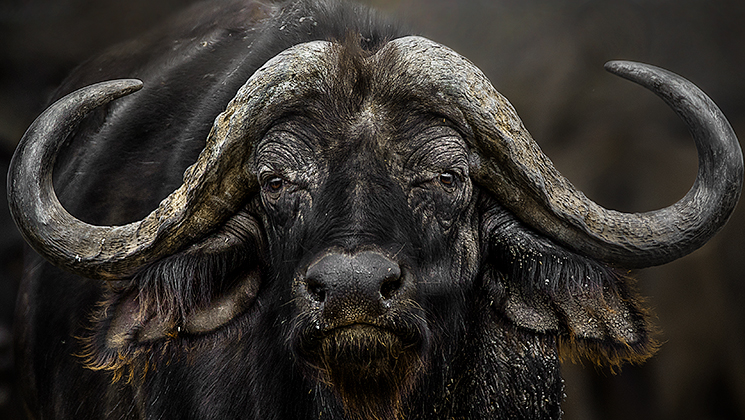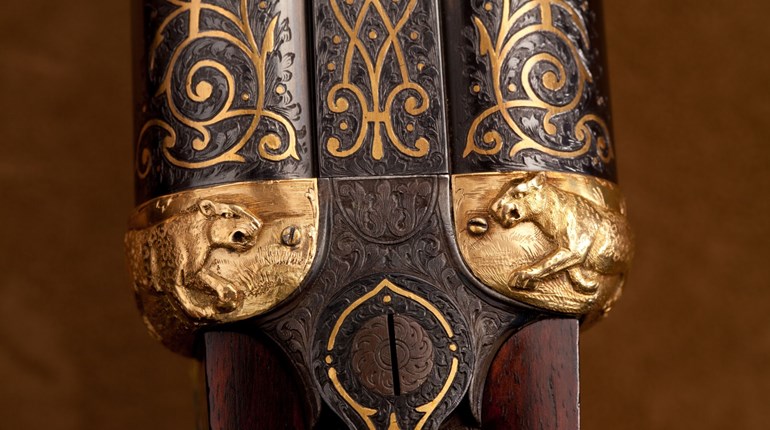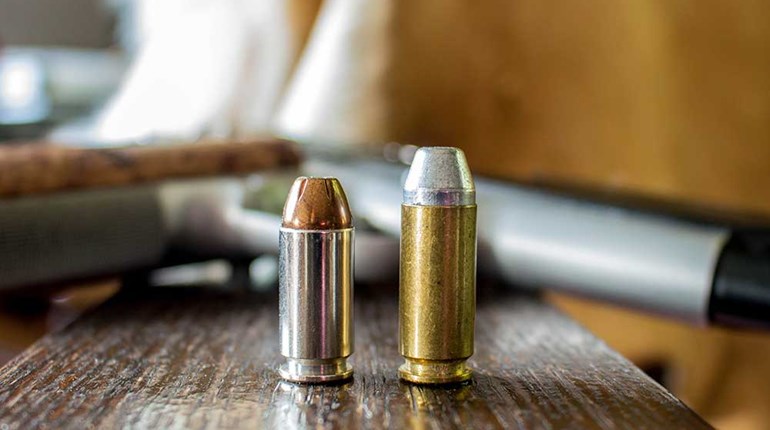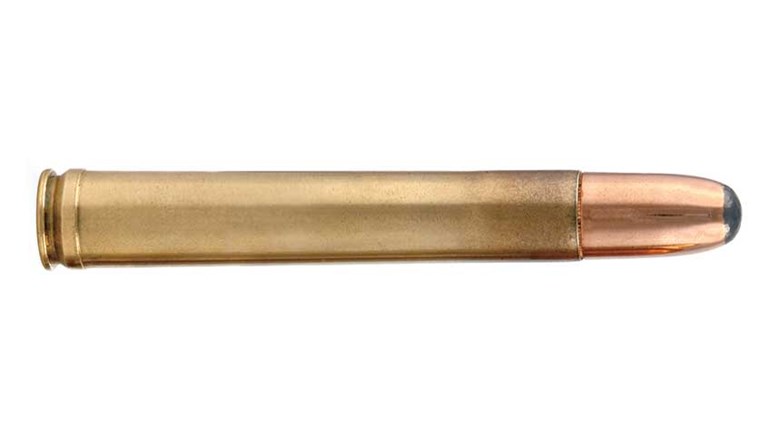
“Everywhere it was buffalo, and more buffalo. I wonder whether the North American plains could’ve compared with this, in herds of bison, before the coming of the white man.”
—Harry Manners, writing in Kambaku, on the size of buffalo herds in the Marromeu swamps
The charter flight was a bit bumpy (I don’t fly well to begin with), and though we had seen large herds of buffalo, sable and hartebeest from the air I was happy to have my feet planted on terra firma. It was the last hunt of the season, and as if Mozambique’s Zambezi Delta wasn’t naturally humid, Mother Nature had dialed up the temperature. No matter, we were there to hunt buffalo with a fantastic new rifle, so a bit of heat and humidity wouldn’t pose a problem.
My professional hunter, a stout young man named Poen van Zyl, met us at the airstrip, sorted our luggage and offered us refreshment. A couple of cool 2M lagers, the local Mozambican beer, were welcome relief after 28 hours of travel. It was a short drive to camp in the back of the Cruiser; not really long enough for my wife, Suzie, and I to fight off jet lag and sort out the names of a dozen or so people with whom we’d spend the next 10 days. But we were happy to unload at camp and see our quarters, a comfortable masonry building replete with shower, and it wasn’t long after that before we were sitting around the campfire at the lapa.
We were here for more than just a hunt. We were unveiling a new double rifle from Heym: the Model 89B in .450/400 3-inch Nitro Express. We’d booked with Zambeze Delta Safaris to hunt Cape buffalo in the forest area of Coutada 11. My friend Chris Sells, owner of Double Gun Imports (the sole importer of Heym rifles in the States), was on the safari with us, along with cameraman Doug King, as we’d be filming this hunt for an episode of “Tracks Across Africa.”
Poen was showing us around the camp—the mess hall, instructions for the solar-panel-fueled lights in our quarters, etc.—when he took me to the skinning shed. I was mesmerized by the buffalo skulls and horns when he uttered a phrase that snapped my head around and caused me to lock up like a pointer: “Our skinning shed used to be Harry Manners’ butchery, when he hunted here to provide buffalo meat for the sugar plantation. Harry would shoot buffalo in exchange for the opportunity to hunt elephant.”
“Wait, you mean the Harry Manners?!” I asked. “Like, the guy with the Winchester .375 H&H who shot more than a thousand elephants? The guy who shot a bull with tusks weighing 185 and 183 pounds? He hunted here?”
“Oh yeah,” replied Poen. “If you’ve ever read his book Kambaku—he wrote all about the Marromeu swamps, right here in this block.”
Oh man, this just got even better. I’d taken an elephant in the very same region of Zimbabwe that Frederick Courteney Selous hunted. Now, to hunt the same ground that Harry Manners did was unreal.
I unpacked my rifles, my trusted Heym Express by Martini, in .404 Jeffery, and that sweet new Heym 89B in .450/400 NE. I had handloaded the ammo for both rifles with 400-grain softpoints and solids from Peregrine Bullets of South Africa. These monometal projectiles are fast-gaining a reputation for devastating terminal performance and high weight retention, and both rifles would put them into more-than-acceptable groups at the range. Clothing, bino, ammo belt and all the accoutrements were in good order. The next morning at the range, the iron sights of the double and my Swarovski 1X-6X scope were spot on, despite the long journey and the best efforts of the baggage handlers. (I lose a padlock or two from my gun case on every trip.)
The remainder of the day was spent trying to cut buffalo spoor in the forest. I couldn’t help but picture Harry Manners following trackers with that .375 over his shoulder, on the trail of big ivory. We had chosen the forest area of Coutada 11 so as to take the Heym 89B on a traditional tracking buffalo hunt; despite the enormous herds of buffalo in the swamps of the Zambezi River Delta, the shots there can be a bit too long for an iron-sighted double. A rifle of this style and pedigree belongs in the thickets, behind the amazing trackers who seem to see things we hunters cannot.
 The Hunt
The Hunt
It was on our second full day when we found the first sign of buffalo—the head tracker, Gorchie, spotted a set of tracks. Upon inspection, it was a cow and a calf, not the dagga boys we were after, so we continued on in our search.
The sun was already high in the sky, and there was talk of lunch when the unmistakable cow-patty and urine stain in the middle of the sand road showed us more buffalo were nearby. There was no need for discussion. There were enough tracks to realize this was a herd of 20 buffalo, maybe more. This particular area of the huge concession consists of very thick forest, interspersed with dried pans of water and some openings in the midst of the thick stuff. We were examining the spoor, not very far from the truck, when Gorchie said two magical words: “Baas, nyati.”
Yup, Gorchie had spotted the herd, maybe a half-mile across a narrow, oblong opening in the forest. The problem? The wind was completely wrong. This did require a bit of planning, as the tracks indicated a good-sized bull in this herd. To get to them we’d have to make a long, arduous fish-hook of a trek through that vine-infested mixture of mahogany and teak.
“Phil, drink some water,” said Poen. “It’s gonna be hot and we may be walking for quite a while, depending on what the herd does.”
Water was consumed, rifles were loaded, ammunition belts secured, and Poen and Gorchie planned a route. It required seven of us to quietly and accurately creep through the thick vegetation. We hoped to exit the forest—burned in some places, and lush green in others—on the downwind side of the herd. In that forest, where the possibility of bumping an elephant or buffalo certainly existed, I was more than happy to carry an iron-sighted .450/400. The Heym rifle had an unequaled balance, and its quick second shot surely engendered more than a bit of confidence. We used elephant trails where we could find them, for both speed and silence, but we were forced to traverse the thick patches by crawling over and under fallen trees and the tangles of vines and creepers. At one point, Gorchie left us behind to creep to the edge of the opening to spy the location of the herd, and returned with good news: They were still feeding on the far side of the clearing. Our trek took us well over a mile, and I could tell we were turning into the wind when Gorchie slowed his pace considerably then did that famous squat-point-freeze move that trackers do when they spot buffalo that are close.
I could see them. Well, I could see some ears flicking and tails twitching, but the herd was a ball of black shapes in the dappled light of the forest’s edge. Poen motioned Gorchie and me behind the base of a burned tree for a quick conference. “Phil, there’s a good bull in this herd, on the left side,” he said. “But we must crawl from here to get the shot.” So, crawl we did.
Wearing shorts, and carrying a rather expensive rifle in my right hand, crawling was a great experience—not. There was a wonderful selection of thorns and various sharp things on the forest floor, all of which did their best to draw blood. The combination of sun, excitement and ash from the burned areas had turned my mouth into a desert. The herd was still feeding calmly, and we slowly crept to within about 45 yards. I could then see the bull, my bull, head down, surrounded by three cows and a calf. I sat up, leaning the rifle on a small sapling that made a convenient rest, and watched my bull come clear of the others. Just as Poen was about to tell me to take him, that bull decided it was high time for a midday nap and proceeded to lie down, on our edge of the herd, slightly quartering toward us. With his vitals all compressed, this didn’t make for my favorite shot, but Poen was completely convinced it could be done, and done right.
“You want to take him just under that left horn; slip that bullet in there and he’s yours,” said the PH. We used binoculars to verify there was no brush in the way, which might deflect the bullet, and I took a good grip on the sweet marriage of walnut and steel. The fine white bead nestled perfectly in the wide V rear sight, and I held about an inch under the lower curl of his horn. I’ll never forget the glint of sunshine off the well-worn bosses, nor the glare off his wet nose. I broke the right trigger of the 89B, and at the shot all hell broke loose.
Buffalo were everywhere, covering up my bull before I had time to give him the left barrel. The herd—and my bull—headed out to a small island of trees in that open area, and his attendants surrounded the wounded bull. We had to wait for him to become clear of the others, which seemed like an eternity as they smelled and poked him with their horns. I was able to get another bullet into the bull as the herd began to clear out, and I actually knocked him down. However, the tenacious qualities of a Cape buffalo are not exaggerated, and this bull was especially tough. He ran off another couple hundred yards, going down in a small clump of trees. His head was still up, however. It took another right and left from the Heym 89B before the bull was down and out. It was the first animal taken with the new rifle. The privilege of taking a buffalo with a classic cartridge on hallowed ground was enormous.
The Bond
With the buffalo down, with photos taken and a considerable amount of video footage shot, we loaded the bull into the Cruiser for delivery to the village of Peau (this was a non-export hunt; all the buffalo belonged to the people). Zambeze Delta Safaris provides a huge amount of meat to the native residents within the hunting concessions. Combined with their zealous anti-poaching operation, this makes for a flourishing game population.
Delivering this buffalo was an eye-opening experience for all of us. We met the local villagers, and via translator, learned just how important this source of protein is to them. Children, holding even smaller children, gathered with their mothers to receive a ration of buffalo meat. Nothing at all went to waste. Smiling families, provided with food that is otherwise unobtainable, were as grateful to receive as I was to give. We found my first bullet deep in the entrails, and I pocketed it for examination. Within minutes, what was earlier a buffalo was en route to the myriad grass-and-mud huts that comprised the village, carried in small pieces in hands, and in baskets and buckets on heads. But it was on the way back to camp, with the sun sinking toward the horizon, when the whole safari was made for me.
The Honor
“Hey, Phil: Do you wish to meet one of Harry Manners’ trackers?” asked Poen, his head craned out the driver’s-side window to speak to me up in the high seat in the rear. I can’t exactly print my response, but it was emphatically in the affirmative.
The man was walking down the road, with an umbrella in one hand, wearing shoes that were more feet than shoes. He had cataracts and the limp that comes from the bad back of old age; if I had to guess, I’d say he was in his late 60s. His name was Domingos Martenote, I soon learned, and he started his hunting career with Harry as the hunter’s young gun bearer, eventually becoming Harry’s official lion caller. It took two translators, but I got Domingos to sit down with me for an interview on camera. He told stories of the huge elephants that Harry took, and even gave us a demonstration of his lion-calling technique.
Most folks in rural Africa don’t live to see his age. It was a pleasure to watch that man, bent with the fatigue of old age, become animated as he recounted his days hunting with Harry Manners and enthusiastically demonstrate his lion-calling technique. The honor of preserving his experiences on video was very special to me, and although it took two translators, we were able to joke with one another. His smile was infectious. Thank you, Domingos. It was wonderful to meet you.






































